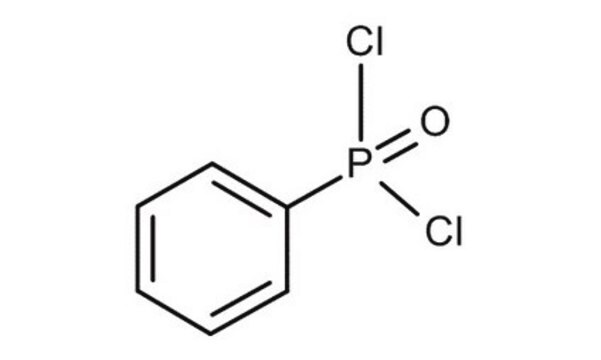If this product has an expiration or retest date, it will be shown on the Certificate of Analysis (COA, CofA). If there is no retest or expiration date listed on the product's COA, we do not have suitable stability data to determine a shelf life. For these products, the only date on the COA will be the release date; a retest, expiration, or use-by-date will not be displayed.
For all products, we recommend handling per defined conditions as printed in our product literature and website product descriptions. We recommend that products should be routinely inspected by customers to ensure they perform as expected.
For products without retest or expiration dates, our standard warranty of 1 year from the date of shipment is applicable.
For more information, please refer to the Product Dating Information document: https://www.sigmaaldrich.com/deepweb/assets/sigmaaldrich/marketing/global/documents/449/386/product-dating-information-mk.pdf
389560
Phenylphosphonic dichloride
technical grade, 90%
Synonym(s):
Benzenephosphonic dichloride, Benzenephosphonyl chloride, Phenyldichlorophosphine oxide, Phenylphosphonyl dichloride, Phenylphosphoryl dichloride, P,P-Dichlorophenylphosphine oxide
About This Item
Recommended Products
grade
technical grade
Quality Level
Assay
90%
form
liquid
reaction suitability
reaction type: Buchwald-Hartwig Cross Coupling Reaction
reaction type: Heck Reaction
reaction type: Hiyama Coupling
reaction type: Negishi Coupling
reaction type: Sonogashira Coupling
reaction type: Stille Coupling
reaction type: Suzuki-Miyaura Coupling
reagent type: ligand
refractive index
n20/D 1.559 (lit.)
bp
258 °C (lit.)
mp
3 °C (lit.)
density
1.375 g/mL at 25 °C (lit.)
SMILES string
ClP(Cl)(=O)c1ccccc1
InChI
1S/C6H5Cl2OP/c7-10(8,9)6-4-2-1-3-5-6/h1-5H
InChI key
IBDMRHDXAQZJAP-UHFFFAOYSA-N
Looking for similar products? Visit Product Comparison Guide
Application
It can be used:
- In the synthesis of PBPP (3,9-diphenyl-3,9-dioxa-2,4,8,10-tetraoxa-3,9-diphosphaspiro-5,5-undecane), another organo-phosphorus flame retardant.[2]
- As a reactant in the synthesis of perfluoroalkyl(phenyl)phosphinic acids from perfluoroalkyl Grignard reagents.[3]
- As a starting material for the synthesis of benzoxazine monomer containing phenylphosphine oxide which can be polymerized via ring-opening polymerization.[4]
- As a chlorinating agent for the conversion of thienopyrimidinedione into 4,6-dichlorothienopyrimidine.[5]
Signal Word
Danger
Hazard Statements
Precautionary Statements
Hazard Classifications
Acute Tox. 4 Oral - Eye Dam. 1 - Skin Corr. 1B - STOT SE 3
Target Organs
Respiratory system
Supplementary Hazards
Storage Class Code
8A - Combustible corrosive hazardous materials
WGK
WGK 3
Flash Point(F)
399.2 °F
Flash Point(C)
204 °C
Personal Protective Equipment
Choose from one of the most recent versions:
Already Own This Product?
Find documentation for the products that you have recently purchased in the Document Library.
Customers Also Viewed
-
How can I determine the shelf life / expiration / retest date of this product?
1 answer-
Helpful?
-
-
How is shipping temperature determined? And how is it related to the product storage temperature?
1 answer-
Products may be shipped at a different temperature than the recommended long-term storage temperature. If the product quality is sensitive to short-term exposure to conditions other than the recommended long-term storage, it will be shipped on wet or dry-ice. If the product quality is NOT affected by short-term exposure to conditions other than the recommended long-term storage, it will be shipped at ambient temperature. As shipping routes are configured for minimum transit times, shipping at ambient temperature helps control shipping costs for our customers. For more information, please refer to the Storage and Transport Conditions document: https://www.sigmaaldrich.com/deepweb/assets/sigmaaldrich/marketing/global/documents/316/622/storage-transport-conditions-mk.pdf
Helpful?
-
Active Filters
Our team of scientists has experience in all areas of research including Life Science, Material Science, Chemical Synthesis, Chromatography, Analytical and many others.
Contact Technical Service













